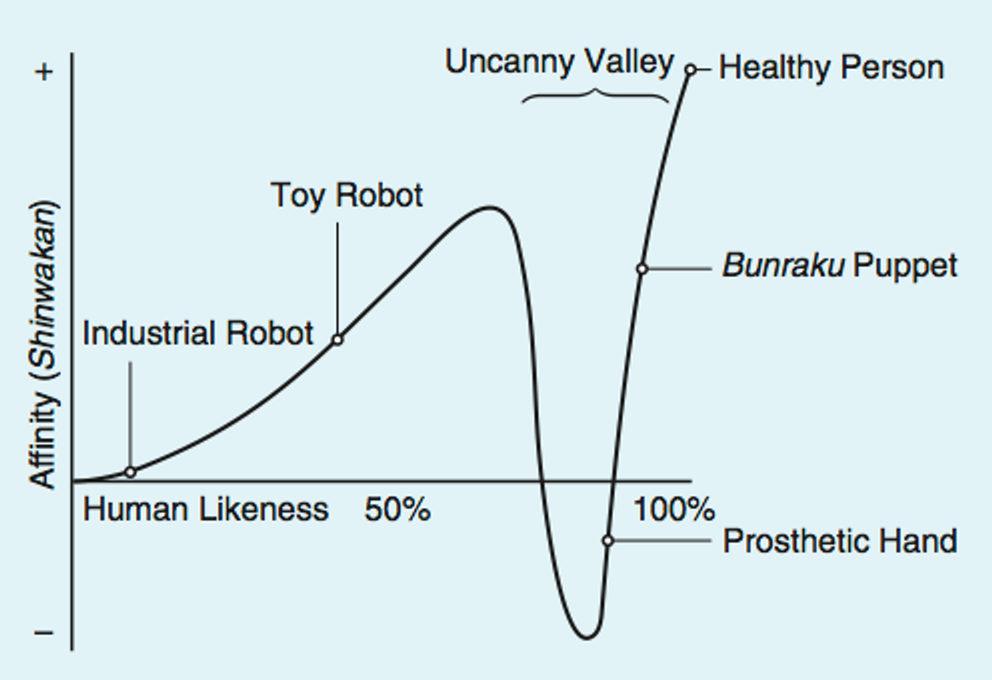If you’ve ever heard of the uncanny valley, you know it’s that strange, unsettled feeling people sometimes get when something looks almost human but doesn’t quite make it all the way.
"Dude, that's just creepy."
In my view — and I’ll back this up — the ETS TOEFL Speaking avatars do not live in the valley.
They’re not creepy, unsettling, or eerie. They’re professional, neutral, and designed to deliver prompts without distracting test-takers.
Let’s break it down.
By the way, if you are new to the Interview task, check out my video about it and/or my blog post about it.
What is the Uncanny Valley?
The term was introduced in 1970 by Japanese robotics professor Masahiro Mori. He observed that as robots and other human-like representations become more lifelike, people’s comfort and affinity generally increase. But only up to a point.
Once a design becomes almost real — but still imperfect — comfort drops sharply into what Mori called the uncanny valley. The closer you get to true realism without reaching it, the more the subtle imperfections stand out. That’s when people start feeling uneasy.

Mori’s Recommendation
Mori’s advice to designers was to avoid the valley entirely by aiming for a safe, moderate level of human likeness. In other words, don’t try to make something so real that tiny imperfections ruin the illusion.
He compared it to eyeglasses: they don’t look like eyeballs, but they serve their purpose and can even be stylish.
Where ETS Fits on the Curve
ETS’s 2026 TOEFL Speaking avatars aren’t in the creepy zone. I’ve reviewed them frame-by-frame and in motion. Here’s why they sit comfortably on Mori’s first peak:
- Facial realism: Natural skin tone, lighting, and proportions.
- Eye and mouth behavior: Smooth, consistent, and in sync.
- Presentation style: Professional but neutral — think corporate training video, not hyper-real CGI.
- Emotional tone: Calm, non-distracting, and focused on delivering the task.
Human Likeness vs. Comfort
Here’s a simplified view of where ETS avatars fall on Mori’s curve:
Why This Matters for TOEFL Speaking Prep
When you prepare with ETS-style avatars:
- You’re practicing in the same environment you’ll see on test day.
- You’re reducing surprise — no distractions from the look or style of the interviewer.
- You’re focusing on your speaking performance, not the medium.
In other words, you’re training for authenticity, not to tolerate creepiness.
Video Example
FAQ
Q: What exactly is the uncanny valley?
A: It’s the drop in comfort people feel when something looks almost human but is slightly off, causing unease.
Q: How do you know ETS avatars aren’t in it?
A: Their realism is moderate and safe. They don’t have the mismatched lip-sync, odd eye focus, or jerky motion that trigger the valley effect.
Q: Why not use a real human video instead of an avatar?
A: ETS uses avatars for standardization — same delivery for every test-taker. In prep, replicating that keeps training conditions consistent.
Q: Could making them more realistic cause a problem?
A: Yes — pushing toward hyper-realism without perfection risks dropping into the uncanny valley. ETS avoids that by keeping things in the safe “first peak” zone.
Q: Is there any pedagogical benefit to being in the uncanny valley?
A: Not for TOEFL prep. Here, the goal is comfort and authenticity, not discomfort tolerance.
Further Reading
Masahiro Mori’s Uncanny Valley Concept — IEEE Spectrum